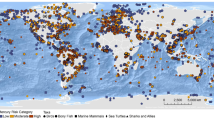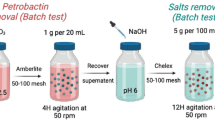Abstract
High-precision isotope composition determinations using multicollector, magnetic-sector inductively coupled plasma mass spectrometry (MC-ICPMS) have recently revealed that some transition metal isotopes such as those of Mo, Fe, Cu, Zn etc. can be used as biogeochemical tracers in global change research. The Mo isotope system may be useful in paleoredox investigations indicating that δ97/95Mo in seawater may co-vary with changes in the relative proportions of anoxic and oxic sedimentation in the ocean, and that this variation may be recorded in δ97/95Mo of anoxic sediments. The Mo continental flux into the oceans and the global Mo isotope budget can be estimated from δ97/95Mo values. The Fe isotope composition in seawater is an important issue because Fe plays a controlling role in biological productivity in the oceans and its abundance in seawater may have substantial effect on climate changes. Iron isotope fractionations could result from bio- and abio-processes and have about 0.1% variation (δ56/54Fe), so Fe isotopes considered alone cannot be used to distinguish the products of abiotic and biotic Fe processing in geological records. Cu and Zn isotopes are also used as biogeochemical tracers, but the researches are relatively less. This review mainly focuses on the methods for preparation, purification and determination, of new isotope tracer samples, and on isotope applications in marine environmental changes.
Similar content being viewed by others
References
Anbar, A. D., K. A. Knab and J. Barling, 2001. Precise determination of mass-dependent variations in the isotopic composition of Mo using MC-ICP-MS.Anal. Chem. 73: 1 425–1 431.
Anbar, A. D., J. E. Roe, J. Barling et al., 2000. Nonbiological fractionation of iron isotopes.Science 288: 126–128.
Barling, J., G. L. Arnold and A. D. Anbar, 2001. Natural mass-dependent variations in the isotopic composition of molybdenum.Earth and Planetary Science Letters 193: 447–457.
Beard, B. L., C. M. Johnson, L. Cox et al., 1999. Iron isotope biosignatures.Science 285: 1 889–1 892.
Bullen, T. D., A. F. White, C. W. Chulds et al., 2001. Demonstration of significant abiotic iron isotope fractionation in nature.Geology 29: 699–702.
Calvert, S. E., T. F. Pedersen and R. E. Karlin, 2001. Geochemical and isotopic evidence for post-glacial palaeoceanographic changes in Saanich Inlet, British Columbia.Marine Geoology 174: 287–305.
Crusius, J., T. F. Pedersen, S. E. Calvert et al., 1999. A 36kyr geochemical record from the Sea of Japan of organic matter flux variation and changes in intermediate water oxygen concentrations.Paleoceanography. 14: 248–259.
Crusius, J., S. E. Calvert, T. F. Pedersen et al., 1996. Rhemium and molybdenum enrichments in sediments as indicators of oxic,suboxic and sulfidic conditions of deposition.Earth Planet. Sci. Lett. 145: 65–78.
Duan, Y., J. M. Song, M. M. Cui et al., 1998. Organic geochemical studies of sinking particulate material in China sea area (I) Organic matter fluxes and distributional features of hydrocarbon compounds and fatty acids.Science in China (Series D) 41(2): 208–214.
Ganeshram, R. S., T. F. Pedersen, S. E. Calvert et al., 2002. Reduced nitrogen fixation in the glacial ocean inferred from changes in marine nitrogen and phosphorus inventories.Nature 415: 156–159.
Halliday, A. N., M. Rehkamper, D. C. Lee et al., 1996. Early evolution of the Earth and Moon: new constrains from Hf-W isotope geochemistry.Earth Planet. Sci. Lett. 142: 75–89.
Halliday, A. N., D. C. Lee, J. N. Christensen et al., 1998. Applications of multiple collector ICPMS to cosmochemistry, geochemistry and paleoceanography.Geochim. Cosmochim. Acta. 62: 919–940.
Marechal, C. N., E. Nicolas, C. Doucher et al., 1999. Precise analysis of copper and zinc isotopic composition by plasma-source mass spectrometry.Chem. Geol. 156: 251–273.
Morford, J. L. and S. Emerson, 1999. The geochemistry of redox sensitive trace metals in sediments.Geochim. Cosmochim. Acat 63: 1 735–1 750.
Pedersen, T. F., B. Nielsen and M. Pickering, 1991. Timing of late quaternary productivity pulses in the Panama basin and implications for atmospheric CO2.Paleoceanography 6: 657–677.
Rehkamper, M. and A. N. Halliday, 1999. The precise measurement of Tl isotopic compositions by MC-ICP-MS: application to the analysis of geological materials and meteorites.Geochim. Cosmochim. Acta. 63: 935–944.
Song, J. M., 1997. Biogeochemical process of major elements in sinking particulate of Nansha coral reef lagoons, South China Sea.Acta Oceanological Sinica 16(4): 557–562.
Song, J. M., 2000a. Marine Chemistry in China, Beijing: China Ocean Press. p. 193–198. (in Chinese)
Song, J. M., 2004. Biogeochemistry Chemistry of China seas, Jinan: Shandong Science and Technology Press. p. 334–340. (in Chinese)
Song, J. M. and P. C. Li, 1998. Vertical transferring process of rare elements in coral reef lagoons of Nansha Islands, South China Sea.Science in China (Series D) 41(1): 42–48.
Song, J. M., Y. X. Luo, P. C. Li et al., 2000b. Phosphorus and silicon in sediments near sediment-seawater interface of the southern Bohai Sea.The Yellow Sea 6: 59–72.
Song, J. M., H. B. Ma and X. X. Lü, 2002. Nitrogen forms and decomposition of organic carbon in the south Bohai Sea core sediments.Acta Oceanlogica Sinica 21(1): 87–95.
Zhu, X. K., R. K. O’Nions, Y. Guo et al., 2000a. Secular variation of iron isotopes in north Atlantic deep water.Science 287: 2 000–2 002.
Zhu, X. K., R. K. O’Nions, Y. Guo et al., 2000b. Determination of natureal Cu-isotope variation by plasma-source mass spectrometry: implications for use as geochemical tracers.Chem. Geol. 163: 139–149.
Author information
Authors and Affiliations
Additional information
Project supported by Qingdao special project for outstanding young scientists (04-3-JJ-03). “100 Talents Project” and the Science Innovation Key Projects of the Chinese Academy of Sciences (No. KZCX1-SW-01-08) and the National Science Foundation for Young Scientists of China (No. 49925614).
Rights and permissions
About this article
Cite this article
Jinming, S., Pedersen, T.F. Application of transition metal isotope tracers in global change research. Chin. J. Ocean. Limnol. 23, 218–225 (2005). https://doi.org/10.1007/BF02894242
Received:
Accepted:
Issue Date:
DOI: https://doi.org/10.1007/BF02894242




